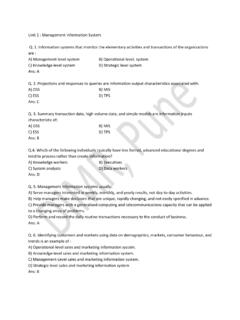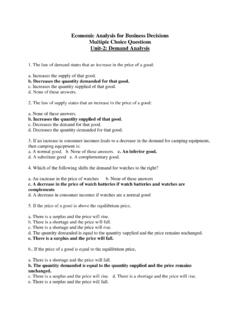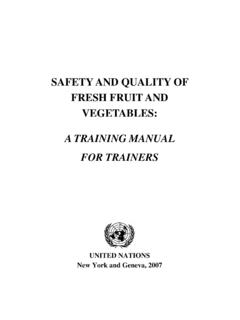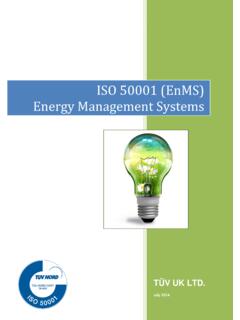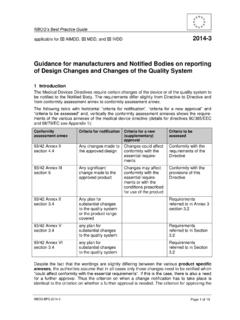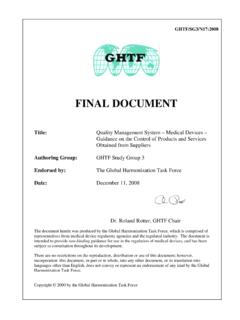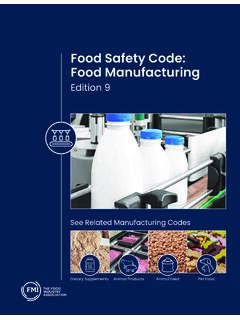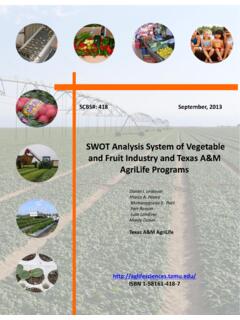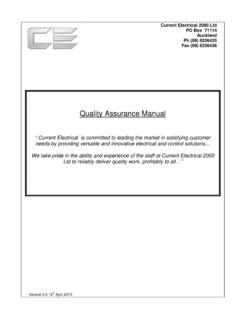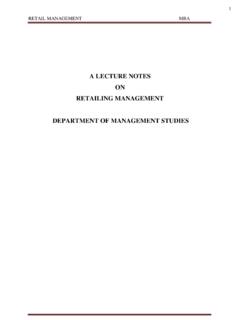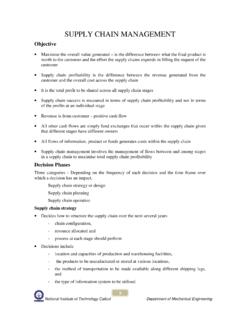Transcription of MCQ: Unit-1: introduction to Operations and Supply Chain ...
1 MCQ: unit -1: introduction to Operations and Supply Chain management 1." quality is defined by the customer" is : An unrealistic definition of quality A user-based definition of quality A manufacturing-based definition of quality A product-based definition of quality 2. According to the manufacturing-based definition of quality quality is the degree of excellence at an acceptable price and the control of variability at an acceptable cost quality depends on how well the product fits patterns of consumer preferences even though quality cannot be defined, you know what it is quality is the degree to which a specific product conforms to standards 3.
2 The Supply Chain concept originated in what discipline? a) marketing b) Operations c) logistics d) production 4. Zero defects in manufacturing is a. is a relevant goal only in electronic assembly b. is readily achievable in all areas c. is the goal of TQM d. is an unobtainable and misleading idea 5. The Supply Chain management philosophy emerged in which decade? 1960s 1970 s 1980s 1990s 6. A _____ encompasses all activities associated with the flow and transformation of goods from the raw material stage, through to the end user, as well as the associated information flows.
3 Production line Supply Chain marketing channel warehouse 7. Which one of the following is not a typical question dealt with by an Operations managers? How much capacity will be needed in the months ahead? What is a satisfactory location for a new facility? How to motivate employees? All are typical of Operations decisions. 8. Which of the following are not key attributes of Supply Chain management ? inventory control leveraging technology customer power all are key attributes 9. Positive, long-term relationships between Supply Chain participants refer to: Co-opetitions tailored logistics partnerships Supply Chain management 10.
4 Which one of the following best represents a pure good? Soap Fast food Attending a play Vehicle repair 11. Which of the following statements is true of LEAN? Lean principles focus on advanced statistical methods Lean principles are separate body of knowledge Lean principles have been developed over a lengthy period of time. Lean principles include reducing waste. 12. The bullwhip effect: is an ineffective way to motivate warehouse employees applies to rodeos and has nothing to do with Supply Chain management refers to the swaying motion associated with triple trailers Refers to variability in demand orders among Supply Chain participants.
5 13. According to the manufacturing-based definition of quality " quality is the degree of excellence at an acceptable price and the control of variability at an acceptable cost" quality depends on how well the product fits patterns of consumer preferences even though quality cannot be defined, you know what it is quality is the degree to which a specific product conforms to standards 14. The variability in demand orders among Supply Chain participants: cannot be controlled refers to the bullwhip effect can be controlled with electronic order placement is more pronounced in relational exchanges 16.
6 Cooperative Supply Chain relationships developed to enhance the overall business performance of both parties is a definition of: third-party logistics Supply Chain collaboration dovetailing relationship marketing 17. Process improvement technique that sorts the "vital few" from the "trivial many" is Taguchi analysis Pareto analysis benchmarking Yamaguchi analysis 18. A fishbone diagram is also known as a cause-and-effect diagram poka-yoke diagram Kaizen diagram Taguchi diagram 19. Which of the following functions is not a core function of an organisation?
7 The Product/Service The Operations Function The Marketing ( Including Sales ) Function The accounting and finance function 20. What is a perfect order? simultaneous achievement of relevant customer metrics an order that arrives on time an order that arrives undamaged an order that is easy for the receiver to fill 21. Total quality management emphasizes the responsibility of the quality Control staff to identify and solve all quality -related problems A commitment to quality that goes beyond internal company issues to suppliers and customers A system where strong managers are the only decision makers A process where mostly statisticians get involved 22.
8 " quality is defined by the customer" is an unrealistic definition of quality a user-based definition of quality a manufacturing-based definition of quality a product-based definition of quality the definition proposed by the American Society for quality Control 23. Which of the following is not one of the major categories of costs associated with quality ? prevention costs appraisal costs internal failures none of the above, they are all major categories of costs associated with quality 24. According to the manufacturing-based definition of quality , quality is the degree of excellence at an acceptable price and the control of variability at an acceptable cost quality depends on how well the product fits patterns of consumer preferences even though quality cannot be defined, you know what it is quality is the degree to which a specific product conforms to standards 25.
9 An important feature of Supply Chain management is its application of electronic commerce technology that allows companies to share and operate systems for: Order processing, transportation scheduling, and inventory management cost-effective flowing of raw materials future purchasing of computer systems future merger opportunities 26. Lean production involves Elimination of cost only Improvement of quality only Improvement of speed only Elimination of all types of waste 27. All of the following costs are likely to decrease as a result of better quality except customer dissatisfaction costs maintenance costs scrap costs warranty and service costs 28.
10 Inspection, scrap, and repair are examples of internal costs external costs costs of dissatisfaction societal costs 29. Which of the following activities is not a direct responsibility of Operations management ? Determining the exact mix of products and services that the customers will want Designing the operation's products,services and processes Developing an Operations strategy for the Operations Planning and controlling the operation 30. Total quality management emphasizes the responsibility of the quality Control staff to identify and solve all quality -related problems a commitment to quality that goes beyond internal company issues to suppliers and customers a system where strong managers are the only decision makers a process where mostly statisticians get involved 31.
